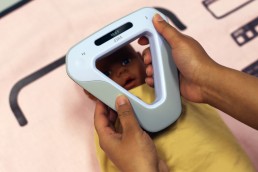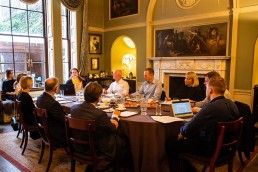Late last year, in collaboration with London-based architecture studio The Manser Practice, Sleeper moderated a roundtable discussion on the topic of patient hotels – a hospitality model emerging in Scandinavia that incorporates medical elements and patient accommodation. The discussion explored what one could learn from the other, as well as how the two mediums could potentially join forces to offer benefits to healthcare system, developer, operator and patient alike.
Just a few months later the discussion seems eerily prescient; the Coronavirus epidemic has struck both hotel markets and healthcare systems worldwide into a generational emergency, as the former sees revenues nosedive thanks to social distancing measures whilst the latter struggles to contain the exponential growth of COVID-19 cases. Hotels are empty and hospitals are spilling over; the math is simple. In the wake of this crisis, the two industries are coming together by necessity.
This began with properties including Gary Neville and Ryan Giggs’ Hotel Football and Stock Exchange Hotel – both Manchester – opening their doors to NHS workers a few days after closing to the public. Then, over 300 of IHG’s London guestrooms were repurposed to allow the homeless – one of the most at-risk communities facing this epidemic – to self-isolate. In the US, meanwhile, OYO Hotels & Homes is offering free rooms for first responders at 300 properties, and in hard-hit New York, Four Seasons continues to provide vital guestrooms for Midtown medical workers on the front lines. Following a surge in such examples, the American Hotel & Lodging Association launched Hotels for Hope in late March – a platform connecting hotels with members of the healthcare community in need of housing.
As cases continue to rise, however, and increasing strain on intensive care units threatens to overwhelm healthcare infrastructure, the possibility of transforming hotels into relief medical units has been touted as a potential solution.
The aforementioned patient hotels are predominantly newbuild, allowing architects and designers to collaborate with healthcare representatives to create structures that streamline and optimise the recovery process, but are often focused solely on recovery as opposed to treatment. Even these hybrid facilities would require some adaptation to serve as functioning emergency wards, and the complexity increases significantly when considering properties that were never intended for medical provision.
As such, the United States Army Corps of Engineers has published the Hotel to Healthcare Concept (H2HC) – a document outlining the necessary layout, equipment and engineering requirements for turning guestrooms into life-saving facilities. The hotel provides the bed, the hospital the medical linens. Carpet is to be removed and replaced by vinyl flooring or epoxy. Privacy curtains stretch between bathroom and desk, and a cast of ventilators, IV stands, electrical outlets and infectious waste storage units are rolled in. The guide demonstrates how a typical floorplan can be retrofitted to allow for proper movement, flow and safety measures, as well as which exterior elements – not least perimeter fencing, generators, screening tents and control points – go where.
It is not a simple process, but nor was building a 1,000-bed hospital from scratch in Wuhan in 10 days, nor the conversion of London’s Excel Centre into the 4,000 bed NHS Nightingale in just nine. Through extraordinary effort, these large-scale projects have mitigated impending disaster for capital city hospitals and their patients, but Coronavirus is proving a truly global pandemic, and easily capable of spreading beyond urban cores if proper lockdown measures are not in place, where massive infrastructure projects come with their own unique challenges. All the while, people continue to give birth, have non-coronavirus related emergencies, and require medical attention for existing conditions as usual.
Maternity experts have recommended that hotels be used as pop-up birth centres – with retired and student midwifes drafted in to staff them – whilst regional properties across the UK have offered themselves as temporary community halfway houses, allowing patients at the end of treatment or in the final stages of recovery to be discharged from hospitals and free up beds. This model – a secondary layer of relief hotels that function to ensure the existing infrastructure is optimised to handle the crisis – could be a more effective strategy. It would see hotels playing a vital role within their capacity, whilst critical patients are receiving care as intended, in an environment designed specifically to handle it.
Even with extensive alterations, some hotels would be unsuited to host critical patients. Consider the many inner-city boutiques that sacrifice space for distinctive style and would likely provide challenging floorplans as three or four buildings are bolted together. These projects may also be impacted considerably more in the long run, as the design they rely upon for revenue is ripped out to ensure a sanitary environment. Even then, research has shown the virus to linger on surfaces for up to 3 days, whilst some strains of SARS and MERS hang around for up to a month. Areas that would not require conversion would nonetheless be contaminated, and once this temporary service is fulfilled, the damage may warrant a full refurbishment. Would the deepest of cleans suffice for the discerning guest this sort of hotel courts?
In these cases, compensation would likely be required, much more so than if governments were to cover an agreeable room rate or install a tax break programme for participating relief hotels. This is not to say that hotels should expect remuneration for providing life-saving services during a time of global crisis, but rather a full-on bail-out is a much tougher barrel to face down than simply recognising authentic gestures of goodwill.
When this uncertain period draws to a close, the reality of patient hotels could be a much brighter prospect, with public, government and patient having witnessed first-hand how the two mediums can work in tandem to create new and improved means of care. At the time of writing, however, most hotels are not hospitals, and reaction time is scarce, if not up.
Despite deep wounds from a flailing economy, hotels have a major role to play in this crisis. If the worst is still to come, then they will become hospitals outright by necessity, and this will likely signal a desperate measure. Until then, in the interests of all parties – hotel, patient and healthcare system – it seems a collaborative relationship as opposed to one of synergy has the potential to save more lives.
Credits
Words: Kristofer Thomas
Image: Tedward Quinn
Related Posts
3 December 2019



